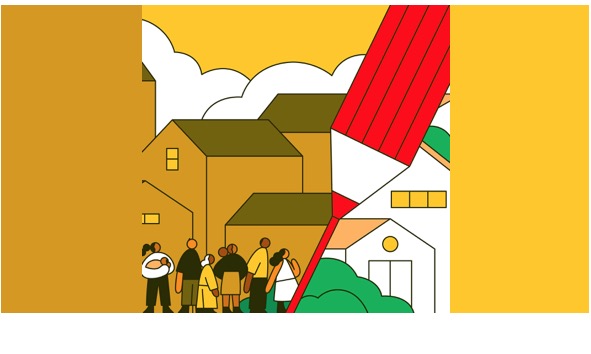Comments
PLANNING WATCH LA - From the 1930’s through the 1960’s, many Los Angeles banks redlined minority neighborhoods by deliberately denying mortgages to their residents.
The Fair Housing Act of 1968 barred all forms of housing discrimination, including redlining and bias by real estate and rental agents. Nevertheless, a recent rationale for up-zoning affluent neighborhoods desired by real estate speculators is that increasing the permitted density of new real estate projects (i.e., up-zoning) counters segregated racial patterns linked to redlining. But, like bogus claims that up-zoning reduces homelessness and economic inequality, the argument that it also reverses segregated housing patterns is flat-out wrong. Up-zoning affluent neighborhood does not reduce racial and ethnic patterns because it increases the value of local properties and creates windfall profits for property owners and developers.
Big surprise that up-zoning makes Los Angeles an even more unequal city and exacerbates racial and economic segregation.
Fair Housing Laws: Current State and Federal fair housing legislation has noticeably reduced racial and ethnic isolation in Los Angeles. California’s 1963 Rumford Fair Housing Law preceded the Federal Fair Housing Act of 1968 by five years. California’s Fair Housing Law was then strengthened in 1988 by the Fair Housing Amendments Act (FHAA).

1930s Redlining Map of Los Angeles
Since the adoption of these laws, LA’s segregated neighborhoods have dramatically shrunk. According to a 2017 Brookings study, LA’s once redlined neighborhoods now have 580,000 non-Black residents and 40,000 Black residents. In fact, the Black population of the old redlined areas was 6.5 percent, compared to 9 percent for the rest of Los Angeles.
These demographic changes resulted from the phenomenal growth of LA’s Latino population, many of whom moved into formerly Black neighborhoods. This has been confirmed by CSUN maps (See below.) documenting the dispersal of LA’s Black population from South Central Los Angeles to other neighborhoods between 1990-2010, largely a result of fair housing laws and Latino migration. Furthermore, these demographic trends continued from 2010 to date.
Lobbying hard for the deregulation of LA’s zoning laws, the YIMBY (Yes in my backyard) group, Abundant Housing calls for up-zoning well-off Los Angeles neighborhoods in order to, they say, reduce racial segregation.
“Only by building more housing can we achieve this goal for people of all backgrounds and needs. Existing exclusionary zoning and land use policies exclude people and are historically rooted in racial and economic segregation. AHLA believes in equity and racial justice as a core part of WHERE and HOW we upzone–that is why we support housing distribution plans that concentrate housing objectively in high-opportunity, job-rich, and transit-served neighborhoods.”
Camouflaged by obfuscating language, LA’s new 2021-2029 General Plan Housing Element offers 136 implementation programs, some of which would up-zone affluent neighborhoods. For example, implementation program 124: Promote and affirmatively further fair housing (AFFH) states;
“Promote and affirmatively further fair housing (AFFH) opportunities throughout the community in all housing, planning and community development activities.
Take a variety of actions to overcome patterns of segregation and foster inclusive communities free from barriers that restrict access to opportunity to promote
diverse communities that grant all Angelenos access to housing. Increase place-based strategies to encourage community revitalization and protect existing
residents from displacement through various policies, programs, and goal setting (e.g., AFH Plan).”
Why these policies will backfire. If implementation programs to monitor housing conditions in Los Angeles eventually appear, they will reveal the folly of up-zoning well-off neighborhoods to achieve racial integration, reduce homelessness, and increase economic equality.
Why? Up-zoning increases property values by allowing real estate developers to automatically build larger, taller, denser buildings with minimal parking. Property owners and real estate developers would no longer require zone variances, zone changes, and density bonuses to reel in lucrative windfall profits. As a result, owners of up-zoned parcels could flip them for immediate financial gain. Alternatively, they could turn to developers to demolish existing buildings and replace them with the highly profitable luxury apartment buildings mushrooming throughout Los Angeles.
This is the essence of the up-zoning programs contained in LA’s new Housing Element. They create instant wealth for property owners and enhanced opportunities for real estate investors and developers. This is one reason why economic inequality continues to rise in LA, and with it, reinforced patterns of racial and ethnic separation.
If the Housing Element’s monitoring programs ever appear, I expect them to fully document these trends. It would pound yet another nail into the coffin of up-zoning’s false promises.
(Dick Platkin is a retired Los Angeles city planner who reports on local planning issues for CityWatchLA. He serves on the board of United Neighborhoods for Los Angeles (UN4LA). Previous Planning Watch columns are available at the CityWatchLA archives. Please send questions and corrections to [email protected].)
















